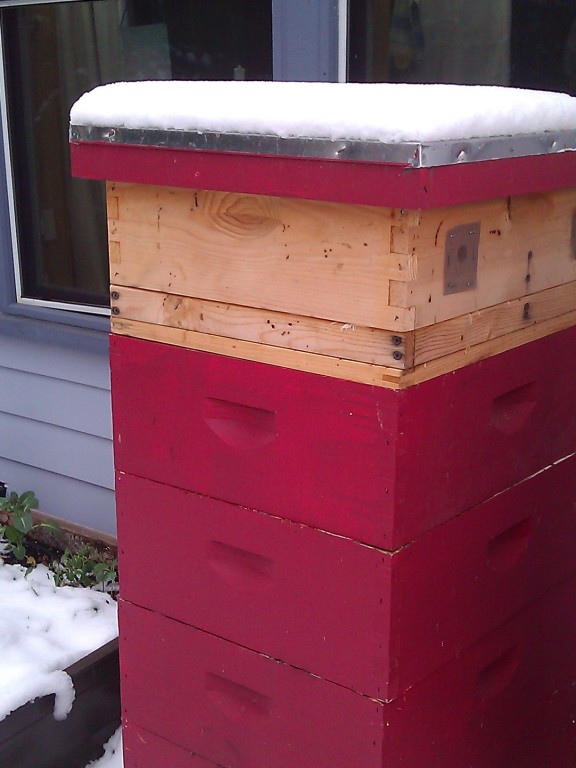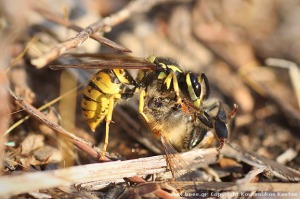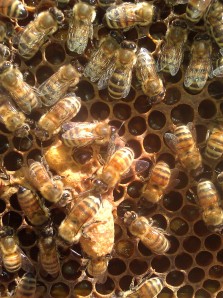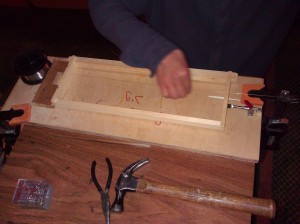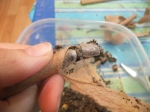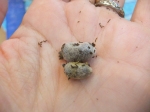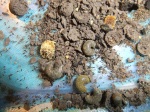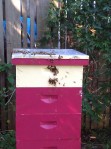
Anybody home?
Through my lack of blogging for the past several months, I can deduce that I am significantly less anxious about beekeeping in year two than I was in year one! July finds both hives doing well and requiring little attention (for the moment), so I will attempt to recount the happenings of the winter and spring.
In November, we began construction on the back of our house, adding a room off the kitchen, which we designed to be sturdy enough to house the hives and some raised beds on the roof. I had hunkered the hives down for winter with the quilt boxes that Dave and I had built, fully expecting to move them onto the roof in February or March, well before they were raising brood and while they were still happily nested into two boxes for overwintering.
However, this being a construction project, the anticipated 6-8 week project grew into a 6 month project. As spring wore on, a pit settled in my stomach as I wondered how on earth I was going to hoist my bee hives, now full of bees raising yet more bees, and actively leaving the hive in search of forage, up onto the roof. I enlisted our contractors for ideas. One brought out a beekeeping buddy, and the two of them discussed complicated strategies, including building temporary scaffolding; or two ladders placed side by side with the hives strapped to a board which they would shoulder as they scaled the ladder; a winch; one guy on the roof with a rope stabilizing the hives while two others shouldered the hives. All of these ideas made my anxious: the potential for dropping the hives and having angry bees stinging the contractors seemed great. I started to wonder if we should leave the bees on the round until winter. Of course, I was also chomping at the bit to landscape the backyard, so leaving the hives on the ground was undesirable.
Finally, the internet offered a solution. We found a heavy duty outdoor stairway which we could install for roof access, instead of using ladders. Once that was in place, I was able to hire a couple of local beekeepers to bundle and move the hives up the stairs one box at a time (and at the time they were at 3 and 4 boxes high). Corky and Brady, the beekeepers, showed up early so the weather would still be cool and the bees huddled inside the hive waiting to start a day of foraging. Dave and I cut plywood to the dimensions of the boxes. The beekeepers strapped these pieces of plywood to the tops and bottoms of each box, and carried them (they weighed 40ish pounds each), up the new stairs to their new home on the roof. After an hour and a half of heavy lifting, the hives were securely in their new home on the roof.
The next step was letting the bees know that their home had moved. As they were (mostly) happily in a closed dark box for the move, their natural response to the move would have been to leave the hive as if nothing had changed, forage, and return home – to the former location. To dissuade this behavior, we obstructed the landing board of each hive with branches. Many of them. The bees were forced to climb over and through these many branches before they could fly off. According to natural beekeeping guru Michael Bush, doing so would give a clue to the bees that they needed to stop and pay attention to their surroundings so that they could find their way back to the new hive location. Otherwise, I ran the risk of having all the forager bees return home to the old location. The branches were like a signal – hey something is different! Pay attention! It worked pretty well, with most of the forager bees returning to the rooftop at the end of the day. However, some of my bees did not get the memo, returning to the old hive location. So, for 3 days I left a small nuc box at the old site. Each evening, I would take the nuc box upstairs and shake the disoriented bees into the smaller hive. After 3 days, I gave up. Some of those bees just weren’t learning. Too bad for them. The remainder settled into life on the roof.
The hives are now located right outside Soren’s window, so I can peek at them frequently to see how things look on the landing board. I do this a lot. After a few weeks of watching the bees, I realized that Galactica hive (the smaller of the two) had fewer bees entering and exiting the hive than Themyscira. A LOT fewer. I had been inspecting the hives regularly, so I was pretty sure that I hadn’t missed a swarm. The queen had been laying in a pretty consistent manner. I opened up the hive and it felt empty. But there was the queen, laying away. I found several frames of broods. Foragers were returning to the hive. So what was wrong? I didn’t know, but some instinct told me to borrow brood from the hive next door to bolster Galactica.
These days I rarely make a hive-related move without consulting my bee group. I emailed the listserv to inquire about the wisdom of propping up my weaker hive with brood. The consensus was that I had nothing to lose (except, potentially, a couple frames of brood). The biggest debate was whether or not to move the nurse bees over with the brood or shake them off first. Given the emptiness of the hive, I opted to move the nurse bees over with the brood. I was concerned that there were too few adult bees in the hive to keep the bees properly warmed. The hive accepted the brood and nurse bees without problem, and after a few weeks seemed to be back on its feet. So what was the problem?
My current theory comes from fellow beek Patti who wondered if drift could be responsible. Drift occurs when the hives are close together and one queen is sending out stronger pheromones than the other. I suspect that Themyscira’s queen has always been the stronger of the two. In fact, that hive may have gotten off to a stronger start because bees from Galactica drifted to Themyscira when I was first setting up the hives. Luckily Galactica’s queen is a scrappy thing and keeps plugging away no matter the odds. Currently the landing boards on both hives show lots of activity. I’m due for an inspection this week, so I should have a better sense of how well the hive has recovered soon!


